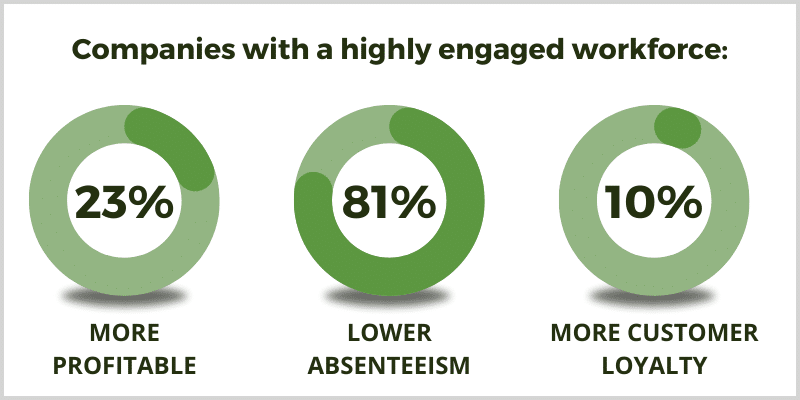What is the Employee Net Promoter Score (eNPS)?
An Employee Net Promoter Score (eNPS) is an easy way of measuring how your employees feel about your company and if they would recommend your company as a good place to work. It is a simple key metric to add to your comprehensive view of the employee experience that helps measure the impact of culture and people initiatives. Your eNPS is based on responses to the question “I would recommend this organization as a good place to work”.
Identifying promoters, passives & detractors
Just this one question can tell you a ton about how your employees really feel about your organization. Here’s how it works:

Based on a 10-point scale, people who give a score of 9 or 10 are Promoters. Those who give a 7 or 8 are called Passives, and people who score between 1 and 6 are known as Detractors.
Promoters are your most positive, satisfied, and motivated employees. They are most likely to advocate for the company.
Passives are neutral. They may be satisfied but are not fully committed.
Detractors wouldn’t recommend your organization and may be unhappy or actively disengaged. Most likely to speak negatively about the company.
eNPS is calculated by subtracting the percentage of Detractors from the percentage of Promoters, which can range from -100 (if every employee is a Detractor) to 100 (if every employee is a Promoter). The percentage of Passives are not included in the eNPS calculation.
Here’s an example of how you would calculate your eNPS if you had 200 employees respond and the results looked as follows:
80 Promoters (40%)
50 Passives (25%)
70 Detractors (35%)
eNPS Equation = (% of Promoters) – (% of Detractors)
40% – 35% = 5% which translates to an eNPS score of 5

eNPS can also be calculated using a 5-point Likert scale using the same calculation above. People who score 5 are Promoters and those who score 4 are Passives. Detractors are people who answer with a 1, 2 or 3.
How to interpret eNPS
eNPS is a helpful tool that is meant to act as a general gauge of your workforce, but it isn’t the end-all-be-all measurement. It is easy to get caught up in comparing your eNPS to others, but the most important benchmark is your own historical comparison. A good eNPS is a score that is higher than your last one. You should also recognize that your industry and culture play a role in determining what is “good”.
For most things, our first instinct is to assume that a score of 0 is bad. For eNPS which is on a scale of -100 to 100, 0 is actually the median or breakeven point. A score of 0 means that you either had 100% Passives or you had an equal percentage of Promoters and Detractors, for example 50% Promoters and 50% Detractors.
A score above 0 means you have more happy employees advocating for the company compared to unhappy employees who may have a negative impact on your employer brand.
As a general guide, scores:
- Above 0 is good
- Above 30 is very good
- Above 50 is excellent and means that at least 50% of employees are Promoters
- Above 80 is best in class
At -100, within the NPS score range, every person who responds is a Detractor. They would not recommend the company and are likely to speak negatively of the workplace.
The Benefits of eNPS
Improved employee retention

Since eNPS is a measurement of the employee experience, improving it can have a positive impact on many aspects of your organization. For example, as you increase your percentage of Promoters, you can assume that your percentage of engaged employees has increased as well. Why is employee engagement important? Engaged employees will help attract new talent, foster innovation, and increase productivity. Compared to organizations with low employee engagement scores, companies with a highly engaged workforce are 23% more profitable, have 81% lower absenteeism, and 10% more customer loyalty. There’s a lot you can do to improve your company culture and make it a place where people enjoy working.
An easy metric to work with
A huge benefit of the employee net promoter score is how easy it is to use. The simplicity of this metric leaves you with a single number. For this reason, it’s a super easy metric to analyze and incorporate into your overall HR strategy. As an employer, you should track how your eNPS progresses, especially when the workplace is going through changes. Using one variable leaves no room for confusion.
Easy to implement
Because of its simplicity, the implementation of the employee net promoter score metric can be straightforward. Based on just one question, you are able to measure if your people would recommend your organization as a good place to work or not. It’s a simple question for people to answer yet provides a lot of insight into your organization. Since this metric only needs one question, it can be used as a standalone question within communications, added to an existing employee survey, or included in any employee feedback strategy.
Directly links to customer satisfaction metrics
Many organizations already use NPS as a customer satisfaction metric. By adding this same measurement into your employee metrics, you can make the connection for relationships between employee sentiment and customer sentiment across different work groups, location, business units, etc. This will provide a more comprehensive view of the organization by using the same metric across employees and customers.
Impact on company culture
If you aren’t already asking employees for their feedback on a regular basis, now is the time to start. Company culture improves when people know their voice has a meaningful impact on the organization. You can use this as an opportunity to show employees you care about what they’re experiencing and share how you intend to use their feedback.

How to Implement eNPS in Your Organization
Creating a safe forum to give feedback
For an unbiased eNPS, employees need to feel “safe” to provide open and honest feedback. This means providing clear communication about how people’s feedback will be used and reassuring participants that their identity won’t be compromised. A great forum to give employees a voice is through confidential employee surveys. Surveys provide your people with a designated space to share their thoughts and opinions, without fear of repercussions.
Choosing the right survey questions
Consider including the eNPS question in an annual engagement survey. This can provide actionable insight into employee’s feeling toward the company while providing more detail into the “why” behind the score. It can also allow you to discover a link between eNPS and other key insights that are already being measured in an engagement survey.
To be a meaningful metric, you need additional detail to help pinpoint what other experiences are linked to eNPS. If you choose to send a standalone eNPS survey, you should consider including a follow-up open-ended question such as “What would improve your score?” or “What would improve the organization as a place to work?”. These follow-up questions allow employees to explain the reason behind their score and provide further detail to help guide action. It takes more digging to find the root causes of an eNPS score and this is why you should consider including it within a comprehensive employee engagement survey.
Determining frequency of eNPS
Measure your eNPS regularly. Having a regular cadence allows you to get enough data to find patterns and trends in the data and more easily pinpoint changes that impact scores. Ideally, your organization should aim to conduct an engagement survey at least once a year. You can also conduct a quick 2-question eNPS pulse survey before and/or after an annual engagement survey to help monitor any changes in employee engagement. Asking too frequently can lead to less participation and may not provide sufficient time for the organization to act on the data received. If employees feel that no action was taken, it can have a negative impact on company culture.
Analyzing eNPS data
One of the biggest benefits of asking the eNPS question within an employee survey is being able to compare the data based on demographics such as department, location, job group, etc. Confidential surveys typically report data in aggregate, meaning responses are connected to demographics at the group level and not at an individual level. This capability allows you to drill down into the data to compare scores between groups and isolate your biggest opportunity areas.

Strategies for Improving eNPS
Communicate results to employees
It is a best practice to be open and transparent with your survey results. Share your eNPS along with any other key metrics gathered from the feedback received. Don’t shy away from vulnerability by noting areas in the results that may have surprised you. Being open might help others to feel comfortable sharing their thoughts. Ask questions to engage people in a conversation, for example, “Are the results what you expected?”
Additionally, this may be a good opportunity to gather more feedback if needed. Encourage people to share their thoughts and ensure they feel safe to express themselves. Show employees that you’re committed to improving low results and value their feedback.
Act on feedback
The best way to ensure you improve your eNPS is to act on the feedback you get. Start by analyzing your data and identifying opportunities to focus on. Once opportunity areas have been discussed, determine what specific actions you and your team can take to improve. It may be obvious what the next action is for your focus area but sometimes, it can be difficult. Employees have a unique insight into what may work or not work and can help generate possible solutions.
Set goals & follow up
To ensure changes are made and not just talked about, set specific goals and a time for completing them. These don’t need to be set in stone but put a stake in the ground for where to start and keep things moving. Check in with employees and managers regularly to see how things are going. Discuss your plan of action with others and see if they have any suggestions for what to consider starting, stopping, and continuing to do. Once significant changes have been implemented based on feedback, set a time to run a follow-up pulse survey to check progress.
Implement a feedback program
As mentioned, eNPS is a useful metric, but it isn’t enough to get a full picture of the employee experience. Since eNPS consists of just one rating question, you’ll need to dive deeper into employee experiences with a more comprehensive feedback strategy.
The foundation of any employee voice strategy is to ask, listen, respond, and connect with people to open the lines of communication. What your employees are experiencing today may very well change in six months or less. Be intentional about your listening strategy so you can adjust and evolve with your people in real time.
Keep in mind, the eNPS is only one piece of the puzzle to understanding your employees’ experiences and shouldn’t be used as the single metric to gauge employee perceptions.
Partner with People Element
People Element’s employee survey platform makes collecting feedback and tracking the eNPS simple. Fully customizable survey templates help you ask the right questions to garner the insights you are looking for while powerful analytics allow you to interpret the data quickly.
If you’re ready to build a better, more engaged workforce, contact us today for a free demo of our powerful platform.





